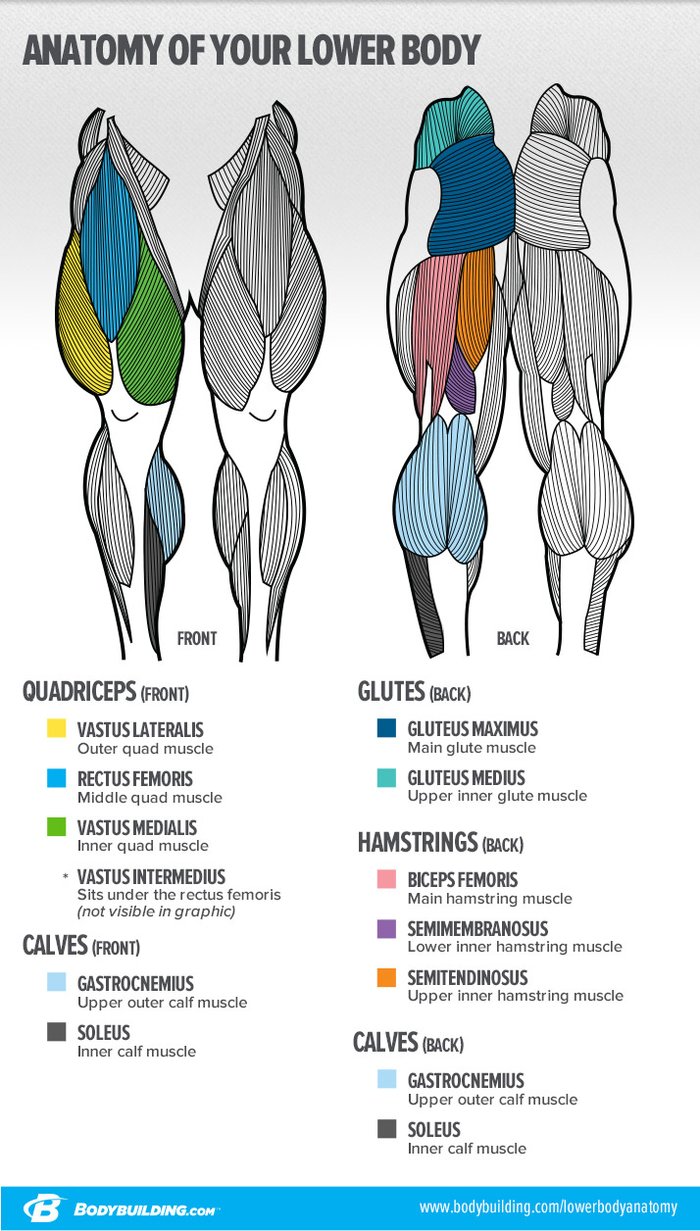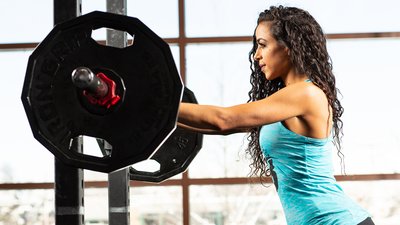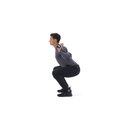If you were to come to me and ask what the world's simplest yet effective leg-day routine is, I would say two words: Just squat. Learn to do it right and hit it hard with several heavy sets of free-weight squats, and you really couldn't go wrong.
Alas, not many serious trainees are looking for the world’s simplest leg day. They want something more grueling; something that feels a bit like, well, a day, one that absolutely demolishes all four major lower-body muscle groups. They want it to be the hardest, most exhausting workout of the week. They crave a workout they can measure by how difficult it is to walk for the next few days.
Nodding your head excitedly? Then you’re ready to enter the world of leg day. Here’s what you need to know before you start.
Lesson 1: Know Your Anatomy
Most muscle groups consist of a few heads, and your best approach is to focus on those heads, both in tandem and individually over the course of your body-part workout. For example, the shoulders have three heads, the biceps two.
Not so with legs. Sure, you have multiple heads, but on leg day, you also have multiple large muscle groups. If you want to be comprehensive, you need to devote some time to the quadriceps (four distinct muscles), hamstrings (three), glutes (two), and calves (two)—not to mention the inner and outer thigh muscles. That's a lot of territory to cover, so unless you can afford to hang out in the weight room all day, you need to get strategic.

In addition to those basic functions, these muscle groups all work in coordination to stabilize your knees and hips. However, the quads and hams are antagonists, meaning when one is contracting the other is being stretched. Oftentimes, as in the squat, the glutes and quads contract together during hip and knee extension. No single exercise works them all optimally, so if you're looking to maximize lower-body development, you'll need your routine to include exercises that emphasize each muscle to varying degrees.
Lesson 2: Start With the Most Challenging Movement
We might have already given away what exercise that is, but unless you've been living under a rock, it shouldn't be news. That's because squat variations work the entire lower-body musculature—albeit a bit less on the hams—while giving a big hormonal boost because of the total-body demands the movement makes.
Of course, there's a never-ending line of guys who are looking for affirmation that another move—say,the leg press—is a suitable alternative. If you're doing this because of an injury, that's one thing. But ask yourself: Is it really just because you don't like squatting? Chances are pretty good that you're on the wrong training track if you're avoiding a particular movement because it's hard and makes you uncomfortable, choosing an easier machine variation instead. But don't just take my word for it. A 2001 study showed that the squat generated significantly greater quad and hamstrings activity than the leg press.1
If you can squat, then squat. Do it first, when your energy level is highest, and do it heavy and hard enough to make it count. The last exercise of your leg day may feel the most grueling, but this one is the most important.
If you simply don't know how to squat, learn. Rather than just sticking a bar on your back, consider starting with an easier front-loaded variation called the goblet squat, which is widely considered one of the finest ways to master squat mechanics.
Lesson 3: Choose the Right Weight
Doing the most difficult movement first in your workout is the right place to start, but that movement is only difficult if it's sufficiently heavy. But how heavy is heavy?
If you go by the bro textbook, it'll say that to build muscle, pick a weight you can do for 3-4 sets of 8-12 reps. However, that's just the main course. Warm-up sets are absolutely critical to those heavier "working sets" because when done properly—i.e., never to failure—they allow you to rehearse a movement pattern and warm up the muscles, both of which can actually enable you to push heavier weights. Heavier weights mean greater muscle stimulation.
Sure, you can use the same weight for each working set and knock out, say, 12, 11, 10, and 8 reps, but that's not the only option. One of my favorite protocols is to push the lower end of the rep spectrum early, before fatigue sets in. To do this, start with a weight you can do for about 8 reps. Then drop the weight and aim for the higher end of the rep range in your later sets.
What about going to failure, you ask? When muscle growth is the goal, this is usually recommended for your 1-2 heaviest sets. However, despite what many will tell you, it's not essential for everyone. While you're learning to squat, it's far more important to hit your reps with good form.
Once you're ready and confident, it's time to fail. When you do, you'll want a good spotter on hand. Be aware that cheat reps are an especially bad idea when it comes to squats because of the dangers to your knees and spine. Keep your reps clean and your form tight. If you can do more reps than the target rep range, the weight is too light, so add weight on your next set. If you can't reach the target rep range, then the weight is too heavy.
Lesson 4: Lower-body multi-joint movements are a must
Many lower-body exercises are multijoint in nature, meaning they require more than one joint to work at the same time. After you've finished your big-dog strength move of the day, these are the ones that are going to make up the core of your lower-body routine. Some options include:
- Front squats
- Single-leg squat variations
- Hack squats (machine or barbell)
- Step-ups
- Squat machine
- Dumbbell squat/sumo squat
- Leg press
Each of these exercises recruits musculature differently based on several factors, including whether you do the move with free weights or on a machine, whether you use one leg or two, how deeply you have to bend your knees or hips, and even where you hold the weight.
How many of these you do on leg day, and how you program them, is going to depend on a number of factors such as your goals, schedule, recovery capabilities, and experience level. To start, it's OK to just utilize a couple of the exercises, as in the sample program below.
A quick tip: On your bilateral leg movements, use a foot position with your feet just a bit wider than hip-width apart, with your feet angled just slightly outward. This will give you a stable position that'll enable you to provide a high degree of force.
Lesson 5: Perform Single-Joint Leg Movements Last
Single-joint movements are where you really focus on a single muscle through a precise movement. Single-joint exercises limit the amount of weight you can use, but they're much easier to recover from than heavy multijoint movements. After your multijoint movements, you'll finish off your muscles with these.
The leg extension is the most common single-joint exercise for the quads, but you have a few choices for the hamstrings. You can do single-joint movements where you bend at the knee, such as the lying leg curl, or ones where you bend only at the hip, such as Romanian deadlifts and stiff-legged deadlifts. You can do both if you have time, or simply alternate between them every few weeks.
On hamstring training: If you usually include it at the end of your workout, but tend to get tired and blow it off—be honest!—consider rearranging your split so that you train hams on another day, preferably two days apart from quad day.
Strengthening your quads without commensurate hamstrings training puts you at a significantly greater risk of serious knee injury because the muscles on one side of the joint are disproportionately stronger than the other side. Hamstring training is not to be skipped!
Lesson 6: Monitor Your Rest Periods
Making across-the-board recommendations on rest periods is never more out of place than on leg day. Because of the degree of muscle mass involved, leg training simply requires longer recovery between sets than other body parts do. If you try to force yourself to rest less than you need, your performance will tank, plain and simple.
On this day, take as long as you need to catch your breath and feel recovered. That might mean three minutes or more on your heaviest sets. Single-joint movements will likely demand less time for recovery. Exercises done unilaterally—that is, one leg at a time—normally require a shorter rest period, because one side is already resting when the other is working. But especially when you're new to this type of training, don't take any hard-and-fast rule to heart. Rest as much as you need to in order to keep performing at a high level.
Lesson 7: Match Your Volume With Your Training Level
It's not enough to choose the right exercises and use the right weights; you also need sufficient training volume. Volume simply means the number of total working sets multiplied by reps. For bodybuilding purposes, high volume is preferred, but "high" can mean different things for different people, depending on their existing musculature, experience level, familiarity with movements, nutrition, supplementation—you get it.
As a rule, you'll get better overall muscle stimulation if you perform multiple sets of an exercise rather than just one. Beginners should do 2-3 working sets of at least 2-3 multijoint exercises, with some additional single-joint work at the end. This type of set-up should provide sufficient training volume to stimulate the lower-body musculature.
- Warm-up sets are not included; do as many as you need, but never take warm-ups to muscle failure.
- Choose a weight that allows you to approach muscle failure by the target rep.

BodyFit
$6.99/month- 2,500+ expert-created single workouts
- 3,500+ how-to exercise videos
- Detailed workout instruction
- Step-by-step workout tips
- Training at gym or at home
- Access to Workout Plans
- Access to Bodyfit App
- Store Discounts
Already have a Bodybuilding.com account with BodyFit? Sign In

What comes with BodyFit?

- Instructional Videos
Don't risk doing a workout improperly! Avoid injury and keep your form in check with in-depth instructional videos.

- How-to Images
View our enormous library of workout photos and see exactly how each exercise should be done before you give it a shot.

- Step-by-Step Instructions
Quickly read through our step-by-step directions to ensure you're doing each workout correctly the first time, every time.
Welcome to Leg Day
Perform the workout weekly for at least six weeks. Six weeks may seem like a long time, but don't worry—you're not advanced enough yet to "get adapted" to the workout, as people say, in just a couple of weeks. You're just learning the ropes, so focus on performing quality work and mastering the motions.
On your workout days, make sure you take in adequate nutrition, both in the form of solid meals and supplementation. As many before you have discovered, leg day is when "nutrition" becomes "performance nutrition."
Then, once you're feeling strong and enthusiastic during the entire workout, you'll be ready for a more advanced routine that utilizes different rep ranges, intensity techniques, and volume. That's when the fun really begins!
References
- Escamilla, R. F., Fleisig, G. S., Zheng, N., Lander, J. E., Barrentine, S. W., Andrews, J. R., ... & Moorman, C. T. (2001). Effects of technique variations on knee biomechanics during the squat and leg press. Medicine and Science in Sports and Exercise, 33(9), 1552-1566.




